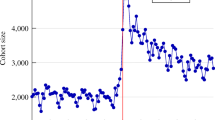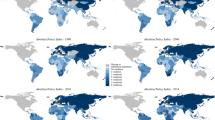Abstract
Using nineteenth century legal information combined with census information, I examine the effect of state laws that restricted American women’s access to abortion on the ratio of children to women. I estimate an increase in the birthrate of 4 % to 12 % when abortion is restricted. In the absence of anti-abortion laws, fertility would have been 5 % to 12 % lower in the early twentieth century.
Similar content being viewed by others
Notes
The interpolation formula is (A + 8B – C) / 16, where A is the 30–39 cohort, B is 40–49, and C is 50–59.
The entire set of citations for these data is not included for brevity’s sake. An example of the basic format of these citations can be found in the entry for the U.S. Census Bureau (2012) in the reference list.
None of the controls listed significantly predict the passage of a law within the next decade using Eq. (1) and law passage as a dependent variable.
Charts and tables examining the nonlinearity of the post period (available from the author) suggest this latter explanation may be correct but are not conclusive given the fragility of the data and the length of the period studied.
References
Ananat, E., Gruber, J., Levine, P., & Staiger, D. (2009). Abortion and selection. The Review of Economics and Statistics, 91, 124–136.
Angrist, J., & Evans, W. N. (1999). Schooling and labor-market consequences of the 1970 state abortion reforms. In S. W. Polachek & J. Robst (Eds.), Research in labor economics (pp. 75–113). Greenwich, CT: JAI Press.
Bailey, M. J. (2010). “Momma’s got the pill”: How Anthony Comstock and Griswold v. Connecticut shaped US childbearing. American Economic Review, 100, 98–129.
Bailey, M. J. (2012). Reexamining the impact of family planning programs on US fertility: Evidence from the war on poverty and the early years of Title X. American Economic Journal: Applied Economics, 4(2), 62–97.
Boland, R., & Katzive, L. (2008). Developments in laws on induced abortion: 1998–2007. International Family Planning Perspectives, 34, 110–120.
Brodie, J. F. (1994). Contraception and abortion in 19th century America. Ithaca, NY: Cornell University Press.
Carter, S. B., Gartner, S. S., Haines, M. R., Olmstead, A. L., Sutch, R., & Wright, G. (Eds.). (2006). The historical statistics of the United States. Cambridge, UK: Cambridge University Press.
Carter, S. B., Ransom, R. L., & Sutch, R. (2004). Family matters: The life-cycle transition and the antebellum American fertility decline. In T. W. Guinnane, W. A. Sundstrom, & W. Whatley (Eds.), History matters: Essays on economic growth, technology, and demographic change (pp. 271–327). Stanford, CA: Stanford University Press.
David, P. A., & Sanderson, W. C. (1986). Rudimentary contraceptive methods and the American transition to marital fertility control, 1855–1915. In S. L. Engerman & R. E. Gallman (Eds.), Long-term factors in American economic growth (pp. 307–390). Chicago, IL: University of Chicago Press.
Degler, C. N. (1980). At odds: Women and the family in America from the revolution to the present. New York, NY: Oxford University Press.
Dellapenna, J. W. (2006). Dispelling the myths of abortion history. Durham, NC: Carolina Academic Press.
Dennett, M. W. (1926). Birth control laws, shall we keep them, change them or abolish them. New York, NY: F. H. Hitchcock.
Easterlin, R. A. (1971). Does human fertility adjust to the environment? American Economic Review, 61, 399–407.
Easterlin, R. A. (1976a). Factors in the decline of farm family fertility in the United States: Some preliminary research results. Journal of American History, 63, 600–614.
Easterlin, R. A. (1976b). Population change and farm settlement in the northern United States. Journal of Economic History, 36, 45–75.
Easterlin, R. A., Alter, G., & Condran, G. (1978). Farms and farm families in old and new areas: The northern states in 1860. In T. K. Hareven & M. A. Vinovskis (Eds.), Family and population in the nineteenth century America (pp. 22–84). Princeton, NJ: Princeton University Press.
Ernst, E. (2002). Herbal medicinal products during pregnancy: Are they safe? BJOG: An International Journal of Obstetrics & Gynaecology, 109, 227–235.
Forster, C., & Tucker, G. S. L. (1972). Economic opportunity and white American fertility ratios 1800–1860. New Haven, CT: Yale University Press.
Gruber, J., Levine, P. B., & Staiger, D. (1999). Abortion legalization and child living circumstances: Who is the “marginal child”? Quarterly Journal of Economics, 114, 263–292.
Guest, A. M. (1981). Social structures and U.S. inter-state fertility differentials in 1900. Demography, 18, 465–486.
Guest, A. M., & Tolnay, S. (1983a). Urban industrial structure and fertility: The case of large American cities. Journal of Interdisciplinary History, 13, 387–409.
Guest, A. M., & Tolnay, S. (1983b). Children’s roles and fertility: Late nineteenth-century United States. Social Science History, 7, 355–380.
Guinnane, T. W. (2011). The historical fertility transition: A guide for economists. Journal of Economic Literature, 49, 589–614.
Guldi, M. (2008). Fertility effects of abortion and birth control pill access for minors. Demography, 45, 817–827.
Haines, M. R. (1986). Comment on new results on the decline in household fertility in the United States from 1750 to 1900. In S. L. Engerman & R. E. Gallman (Eds.), Long-term factors in American economic growth (pp. 426–437). Chicago, IL: University of Chicago Press.
Haines, M. R. (1987). Economic history and historical demography: Past, present, and future. In A. J. Field (Ed.), The future of economic history (pp. 185–253). Boston, MA: Kluwer-Nijhoff Publishing.
Haines, M. R. (2000). The population of the United States, 1790–1920. In S. L. Engerman & R. E. Gallman (Eds.), The Cambridge economic history of the United States (Vol. II): The long nineteenth century (pp. 143–206). Cambridge, UK: Cambridge University Press.
Haines, M. R., & Guest, A. M. (2008). Fertility in New York State in the pre-Civil War era. Demography, 45, 345–361.
Haines, M. R., & Hacker, J. D. (2006). The puzzle of antebellum fertility decline in the United States: New evidence and reconsideration (Working Paper No. 12571). Cambridge, MA: National Bureau of Economic Research.
King, C. R. (1992). Abortion in nineteenth century America: A conflict between women and their physicians. Women's Health Issues, 2, 32–39.
King, M., & Ruggles, S. (1990). American immigration, fertility, and race suicide at the turn of the century. Journal of Interdisciplinary History, 20, 347–369.
Lader, L. (1966). Abortion. New York, NY: Bobbs-Merril Company.
Levine, P. B. (2004). Sex and consequences. Princeton, NJ: Princeton University Press.
Levine, P. B., Staiger, D., Kane, T. J., & Zimmerman, D. J. (1999). Roe v. Wade and American fertility. American Journal of Public Health, 89, 199–203.
McLaren, A. (1990). A history of contraception: From antiquity to the present day. Cambridge, MA: Basic Blackwell.
Mohr, J. C. (1978). Abortion in America: The origins and evolution of national policy, 1800–1900. New York, NY: Oxford University Press.
Polsky, S. (1970). Legal aspects of abortion. Seminars in Psychiatry, 2, 246–257.
Quay, E. (1961). Justifiable abortion–Medical and legal foundations. Georgetown Law Journal, 49, 395–538.
Reed, J. (1978). From private vice to public virtue: The birth control movement and American society since 1830. New York, NY: Basic Books.
Ruggles, S., Alexander, J. T., Genadek, K., Goeken, R., Schroeder, M. B., & Sobek, M. (2010). Integrated public use microdata series: Version 5.0 [Machine-readable database]. Minneapolis: University of Minnesota.
Sanderson, W. C. (1979). Quantitative aspects of marriage, fertility and family limitations in nineteenth century America: Another application of the Coale specification. Demography, 16, 339–358.
Smith-Rosenberg, C. (1985). Disorderly conduct: Visions of gender in Victorian America. New York, NY: Oxford University Press.
Steckel, R. H. (1992). The fertility transition in the United States: Tests of alternative hypotheses. In C. Goldin & H. Rockoff (Eds.), Strategic factors in nineteenth century American economic history: A volume to honor Robert W. Fogel (pp. 351–374). Chicago, IL: University of Chicago Press.
Storer, H. R. (1860). Criminal abortion in America. Philadelphia, PA: J. P. Lippincott & Co.
Storer, H. R., & Heard, F. F. (1868). Criminal abortion: Its nature, its evidence, and its law. Boston, MA: Little, Brown, and Company.
Sundstrom, W. A., & David, P. A. (1988). Old-age security motives, labor markets, and farm-family fertility in antebellum America. Explorations in Economic History, 25, 164–197.
Tolnay, S. E., Graham, S. N., & Guest, A. M. (1982). Own child estimates of U.S. white fertility, 1886–99. Historical Methods: A Journal of Quantitative and Interdisciplinary History, 15, 127–138.
Tolnay, S. E., & Guest, A. M. (1982). Childlessness in a transitional population: The United States at the turn of the century. Journal of Family History, 7, 200–219.
Tolnay, S. E., & Guest, A. M. (1984). American family building strategies in 1900: Stopping or spacing. Demography, 21, 9–18.
U.S. Census Bureau. (2012). Alabama: 2010. Population and Housing Unit Counts (CPH-2-2). Washington, DC: U.S. Government Printing Office, Washington DC. U.S. Census Bureau. Retrieved from http://www.census.gov/prod/cen2010/cph-2-2.pdf
Wahl, J. B. (1986). New results on the decline in household fertility in the United States from 1750 to 1900. In S. L. Engerman & R. E. Gallman (Eds.), Long-term factors in American economic growth (pp. 391–437). Chicago, IL: University of Chicago Press.
Wolfers, J. (2006). Did unilateral divorce laws raise divorce rates? A reconciliation and new results. American Economic Review, 96, 1802–1820.
Yasuba, Y. (1962). Birth rates of the white population in the United States, 1800–1860: An economic study. Baltimore, MD: John Hopkins Press.
Acknowledgments
Thanks to Elizabeth Ananat, Martha Bailey, Dora L. Costa, Laura Dague, Claudia Goldin, J. David Hacker, Michael Haines, Ann McCants, Bob Margo, Karen Norberg, and Lori Taylor for helpful discussions; Michael Haines for assistance with census tables; and state law librarians in many states for assistance with historical abortion laws. Thanks also to seminar participants at APPAM, the University of California at Riverside, the University of Kansas, the NBER Development of the American Economy, Northwestern University, Pomona College, and SSHA; to Jillian Boles, Alejandro Bras, Erin Harrison, Rebecca Willis, and YiDing Yu for excellent research assistance; and to M. Rose Barlow and Mary Cozad for comments. Finally, thanks to three anonymous reviewers for helpful comments. The author thanks the National Institute on Aging NBER Grant # T32-AG00186 for funding and support.
Author information
Authors and Affiliations
Corresponding author
Rights and permissions
About this article
Cite this article
Lahey, J.N. The Effect of Anti-Abortion Legislation on Nineteenth Century Fertility. Demography 51, 939–948 (2014). https://doi.org/10.1007/s13524-014-0293-x
Published:
Issue Date:
DOI: https://doi.org/10.1007/s13524-014-0293-x




